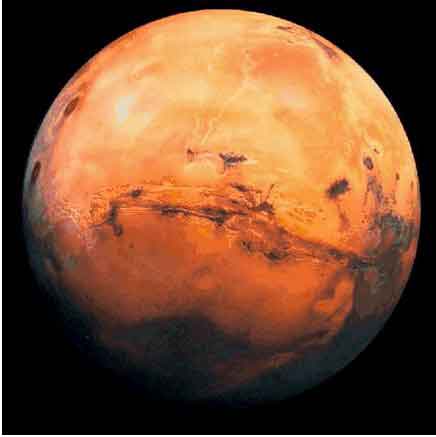Large CO2 clouds on Mars cast dense shadow on surface
 Paris, Jan 17: Scientists have for the first time detected high-level clouds made up of carbon dioxide (CO2) in the atmosphere of Mars, which are so large and dense that they throw dark shadows on the dusty surface of the Red Planet.
Paris, Jan 17: Scientists have for the first time detected high-level clouds made up of carbon dioxide (CO2) in the atmosphere of Mars, which are so large and dense that they throw dark shadows on the dusty surface of the Red Planet.
Observed by the OMEGA Visible and Infrared Mineralogical Mapping Spectrometer instrument on board ESA's Mars Express, these clouds are made up of CO2 ice crystals, or dry ice.
Though clouds of water ice particles do occur on the flanks of the giant Martian volcanoes, this is the first time that high-level clouds have been detected in the atmosphere of the planet.
"This is the first time that carbon dioxide ice clouds on Mars have been imaged and identified from above," said Franck Montmessin of the Service d'Aeronomie, University of Versailles (UVSQ). "This is important because the images tell us not only about their shape, but also their size and density,” he added.
Though data from the SPICAM Ultraviolet and Infrared Atmospheric Spectrometer has previously indicated that any high altitude clouds are not very thick and made up of much smaller particles, the CO2 clouds detected by OMEGA are very different.
Not only are these clouds surprisingly high - more than 80 km above the surface - but they can be several hundred kilometres across as well. They are also much thicker than expected. Instead of looking like the wispy ice clouds seen on Earth, they resemble tall convectional clouds that grow as the result of rising columns of warm air.
Even more startling is the fact that the CO2 ice clouds are made of quite large particles - more than a micron (one thousandth of a millimetre) across - and they are sufficiently dense to noticeably dim the Sun.
"The clouds imaged by OMEGA can reduce the Sun's apparent brightness by up to 40 per cent," said Montmessin. "This means that they cast quite a dense shadow and this has a noticeable effect on the local ground temperature,” he added.
In fact, temperatures in the shadow can be up to 10°C cooler than their surroundings, and this in turn modifies the local weather, particularly the winds.
As for the unexpected shape of the clouds and large size of their ice crystals, it can be explained by the extreme variations in daily temperature that occur near the equator, where these clouds are mostly seen.
"The cold temperatures at night and relatively high day-time temperatures cause large diurnal waves in the atmosphere," explained Montmessin. "This means there is a potential for large-scale convection, particularly as the morning Sun warms the ground," he added.
(ANI)